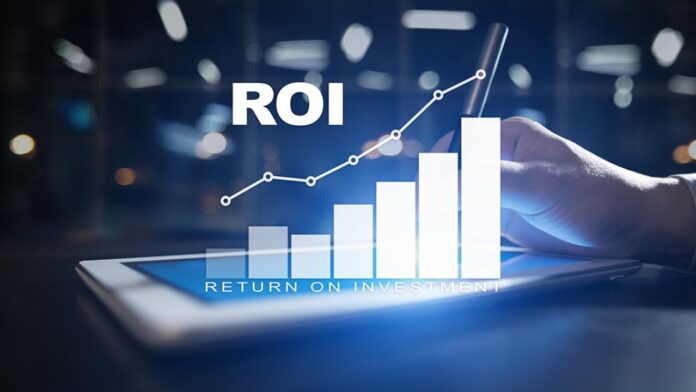Return on Investment vs Return on Invested Capital (ROIC) are two key financial metrics used by businesses and investors to assess the profitability and efficiency of investments.
ROIC is a more focused metric, considering only the funds directly tied to the investment, making it a valuable tool for evaluating individual project performance.
Although they may sound similar, these metrics have distinct characteristics and serve different purposes. This comprehensive guide will delve deep into ROI and ROIC, exploring their definitions, calculations, and applications in the business world. So, let’s embark on this financial journey to understand the significant differences between ROI and ROIC.

Table of Contents
Defining Return On Investment (ROI)
- Understanding ROI Formula
- How ROI Impacts Decision Making
Deciphering Return On Invested Capital (ROIC)
- ROIC Formula Explained
- The Significance of ROIC
Comparing ROI and ROIC
- ROI vs. ROIC: Key Differences
- When to Use ROI
- [When to Use ROIC
Real-Life Examples
- Calculating ROI in Action
- ROIC in Practice
In finance and business analysis, ROI and ROIC are critical performance indicators. They help investors, analysts, and business leaders make informed decisions about investments, expansion, and resource allocation. Let’s start by defining these two metrics individually.
Defining Return On Investment (ROI)
ROI Formula
Return on Investment, often abbreviated as ROI, is a metric used in finance to gauge the return on an investment relative to its cost. The formula for calculating ROI is straightforward:
ROI = (Net Profit / Investment Cost) x 100%
ROI provides a percentage value, representing the return generated from an investment about its initial cost. It’s a valuable tool for assessing the efficiency of investments and deciding whether they are worthwhile.
How ROI Impacts Decision Making
ROI plays a crucial role in decision-making processes. It helps businesses prioritize projects or investments by comparing their potential returns. A higher ROI suggests a more profitable venture, making it an attractive option for resource allocation.
Deciphering Return On Invested Capital (ROIC)
ROIC Formula Explained
Return on Invested Capital, or ROIC, offers a deeper insight into a company’s performance by considering debt and equity investments. The formula for calculating ROIC is as follows:
ROIC = (Net Operating Profit After Tax) / (Total Debt + Shareholder’s Equity)
ROIC provides a more comprehensive perspective on how well a business generates returns on its capital investments. It is particularly valuable for assessing long-term investments.
The Significance of ROIC
ROIC is critical for evaluating a company’s ability to provide income greater than its cost of capital. A high ROIC indicates that the company uses capital effectively to create shareholder value. Conversely, a low ROIC may raise concerns about the company’s operational efficiency.
Comparing ROI and ROIC
ROI vs ROIC: Key Differences
While both ROI and ROIC measure profitability, they differ significantly in their scope and application. ROI focuses solely on the returns generated from an investment, while ROIC considers the utilization of all invested capital, including debt.
When to Use ROI
Use ROI to evaluate the profitability of short-term projects or investments. It is a useful metric for assessing marketing campaigns, product launches, or one-time ventures.
When to Use ROIC
ROIC is best suited for analyzing long-term investments and assessing a company’s financial health. It accounts for the ongoing efficiency of capital utilization, making it valuable for long-term investors and stakeholders.
Real-Life Examples
Calculating ROI in Action
Think of a $10,000 marketing effort and generate $15,000 in additional revenue. Using the ROI formula:
ROI = ($15,000 – $10,000) / $10,000 x 100% = 50%
This indicates that the marketing campaign yielded a 50% return on Investment.
Limitations of ROI
While ROI is a valuable metric, it has its limitations. It needs to consider the timing of cash flows and provide a complete picture of long-term investments.
How is ROIC Calculated?
To calculate the ROIC of a company, you use the book value of items from the balance sheet and the income statement in the following formula:

There are a couple of approaches to calculate both NOPAT and IC. Here are the typical approaches to calculate each item:
- NOPAT = earnings before interest and taxes (EBIT) x (1 – tax rate)
- IC = Book value of debt + Book value of equity – Goodwill – Cash

where t indicates the current period, and t-1 indicates the previous period.
ROIC in Practice
For a comprehensive ROIC analysis, let’s assume a company has a net operating profit after tax of $500,000, total debt of $1,000,000, and shareholder’s equity of $2,000,000. Using the ROIC formula:
ROIC = $500,000 / ($1,000,000 + $2,000,000) = 16.67%
This ROIC percentage signifies the company’s efficiency in utilizing its invested capital.
What are the Requirements for ROIC?
There are three key requirements for ROIC calculation.
- Using after-tax operating income: All income must be after taxes because it has to consider that return to investors and bondholders is subject to applicable taxes.
- Using book value instead of market value: ROIC takes a look at past performance. You can’t use market values because they take into account expectations about future performance.
- Using different time periods: Before your capital can generate returns, you have to invest it. Therefore, invested capital is from a previous period than the one from the NOPAT.
What are the limitations of ROIC?
There are three vital prerequisites for ROIC computation.
Utilizing after-charge working pay: All pay should be after charges since it needs to consider that re-visitation of financial backers and bondholders is dependent upon appropriate assessments.
Utilizing book esteem rather than market esteem: ROIC investigates execution. You can’t utilize market values since they consider assumptions regarding future execution.
Utilizing different time spans: Before your capital can produce returns, you need to contribute it. Thusly, contributed capital is from a past period than the one from the NOPAT.
Moreover, the ROIC is helpless to huge one-time expenses (e.g., an association wide rebuilding) or incomes (e.g., an exceptional advantage from a money vacillation). Some ROICs ought to be placed into setting and may must be recalculated without the one-time cost or income.
ROI vs ROIC: Which One to Choose?
The choice between ROI and ROIC depends on the specific context and the nature of the Investment or analysis. Short-term projects often benefit from ROI assessment, while long-term investments and overall company performance analysis require ROIC.
Maximizing ROI and ROIC
To enhance ROI, businesses should focus on increasing revenue or reducing costs. For ROIC improvement, companies should strive to enhance operational efficiency and manage their capital effectively.
Conclusion
Return on Investment vs Return on Invested Capital, Return on Investment (ROI) and Return on Invested Capital (ROIC) are invaluable tools for assessing the profitability and efficiency of investments.
While ROI is suitable for short-term projects and quick decision-making, ROIC offers a deeper understanding of a company’s long-term financial health. By comprehending the differences and applications of these metrics, businesses can make informed choices to drive growth and success.
FAQs
Can ROI and ROIC Be Used Together to Assess Investments?
Yes, they can be used together to provide a more comprehensive evaluation of an investment. ROI focuses on short-term returns, while ROIC considers long-term efficiency.
Are There Industry-Specific Benchmarks for ROI and ROIC?
Yes, industry benchmarks can help assess whether an ROI or ROIC value is favorable compared to competitors or peers in the same industry.
Can a Company Have a High ROI But a Low ROIC, or Vice Versa?
Return on Investment vs Return on Invested Capital: A company can have a high ROI for short-term projects while maintaining.



